To mix exotic oriental perfumes like a master, you'll need to balance key ingredients using the essential 20% concentration ratio. Start with foundational base notes like sandalwood and cedarwood, then layer in precious resins, spices, and sweet elements. Blend core spices like cinnamon and cardamom with aromatic notes, and test combinations on your skin for unique interactions. Let your creations mature to achieve that authentic oriental depth that centuries of tradition have perfected. The secrets of true mastery await in the ancient art of oriental perfumery.
Understanding the Soul of Oriental Perfumery
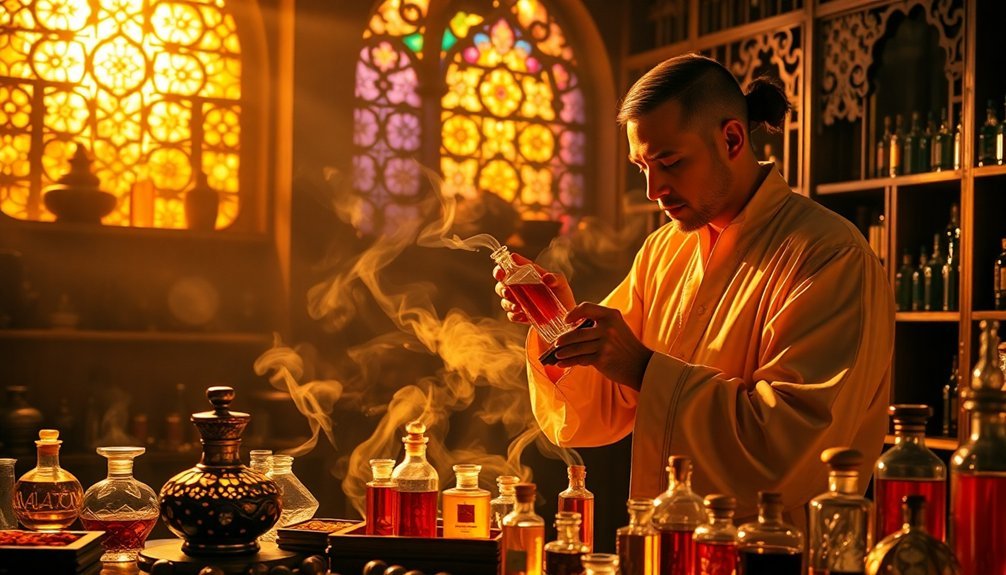
While many fragrances merely captivate the senses, oriental perfumes explore deeper into the domain of emotional and cultural expression.
You'll discover a rich tapestry of complex notes that interweave spices, fruits, and sensual elements, creating a unique symphony of scents with a noble amber heart.
To truly understand oriental perfumery, you'll need to appreciate its deep cultural roots and traditional craftsmanship. The Costume National Soul Parfum exemplifies this with its contemporary romantic essence.
These perfumes aren't just fragrances; they're stories told through scent, drawing from Middle Eastern, Asian, and Mediterranean influences.
The unisex appeal of many oriental perfumes reflects their universal language, speaking through ingredients like bergamot, oud wood, and ambergris.
When you're exploring oriental perfumes, you're not just selecting a scent – you're connecting with centuries of tradition and emotional resonance.
Essential Ingredients for Oriental Perfume Blending
When you're crafting oriental perfumes, you'll need to master the interplay between core spices like cinnamon and cardamom with precious resins such as frankincense and myrrh.
You'll discover that balancing sweet base notes of vanilla and amber creates the signature warmth that defines oriental fragrances.
The selection of precious woods, particularly sandalwood and oud, provides the essential foundation that anchors these complex scent compositions. Adding floral oriental notes creates an enchanting blend of warm elements with rich florals like jasmine and rose.
Core Spices and Resins
To create authentic Oriental perfumes, you'll need to master the essential combination of spices and resins that form their distinctive character.
Start with core spices like black pepper for sharpness, cardamom for aromatic sweetness, and cinnamon for sensual warmth. Clove and nutmeg will add complexity to your blend.
For depth and richness, incorporate resins such as myrrh, styrax, and benzoin. Frankincense adds woody earthiness, while labdanum contributes an amber-like quality.
When blending, layer these ingredients carefully, considering how they'll interact with other fragrance notes. These materials require proper fixatives for stability and enhanced aromatic pleasure.
Remember that resins serve as base notes, providing longevity and foundation, while spices enhance the middle notes.
Test your combinations on scent strips and adjust until you've achieved the perfect balance of warmth, depth, and exotic allure.
Balancing Sweet Base Notes
Mastering the balance of sweet base notes serves as an essential foundation for creating intriguing Oriental perfumes.
You'll want to start with amber, a resinous warmth that forms the heart of Oriental fragrances through a blend of labdanum, benzoin, and styrax.
Vanilla's sweet richness adds a vintage, sensual touch that defines the Oriental family.
Pair it with incense notes like frankincense, myrrh, or oud to introduce ethereal sophistication.
When you're crafting your blend, remember that musk can deepen the warmth, while saffron brings a distinctive heavy scent.
For added complexity, you can incorporate fruity notes like ripe berries or plums.
Don't forget the balancing power of sandalwood and other precious woods – they'll ground your sweet base notes with their earthy qualities.
Precious Woods Selection
The selection of precious woods forms the cornerstone of any sophisticated Oriental perfume.
You'll want to start with sandalwood, prized for its creamy texture and calming properties, which serves as an excellent base note to enhance your blend's warmth and sophistication.
Consider incorporating oud, one of the world's most valuable woods, to add a rich, smoky essence and spiritual dimension to your creation.
For additional depth, you can work with cedar and guaiac wood, which provide essential earthy qualities that ground your fragrance.
To elevate your blend's complexity, experiment with spicy wood combinations.
Mix cinnamon, clove, or cardamom with your chosen woods.
These spicy-wood pairings will create an untamed, exotic character while maintaining the smooth, harmonious balance that's vital in Oriental perfumery.
Mastering the Art of Base Note Selection
When crafting oriental perfumes, selecting the right base notes can make or break your fragrance's success. You'll want to focus on ingredients that provide depth, longevity, and character to your creation.
| Base Note | Character | Best Pairings |
|---|---|---|
| Cedarwood | Woody, Warm | Sandalwood, Cistus |
| Vanilla | Sweet, Rich | Cocoa, Amber |
| Frankincense | Resinous, Complex | Myrrh, Cinnamon |
| Patchouli | Earthy, Deep | Oakmoss, Vetiver |
To create a well-rounded oriental fragrance, you'll need to take into account how these base notes interact with your skin chemistry and environment. Try blending woody notes with sweet elements, or mix earthy components with spicy undertones. Remember that base notes are your fragrance's foundation, determining how long it'll last and what impression it'll leave in memory.
Creating Your Signature Spice Accord

Creating your signature spice accord starts with striking the perfect balance between sweet aromatics like vanilla and cinnamon against hotter elements such as black pepper and ginger.
You'll want to build your base note layers methodically, starting with the heaviest materials and gradually working up to the more volatile spices.
While experimenting with different combinations, focus on selecting complementary accords that enhance rather than compete with your chosen spices, ensuring each element serves a distinct purpose in your oriental composition.
Balance Sweet With Heat
Balancing sweetness with heat creates the signature allure of Oriental perfumes.
You'll want to start with sweet base notes like vanilla bean, tonka bean, or caramel accords, then carefully layer in spicy elements to add warmth and complexity.
Try incorporating pink pepper oil or cinnamon to introduce heat, while patchouli and cedarwood provide earthy depth.
For a sophisticated blend, pair black cherry or plum notes with a sensual spice accord.
You can also balance cotton candy sweetness using bitter almond or smoky leather notes.
When working with florals, combine jasmine sambac or rose essence with warm spices to create depth.
Remember that the key is finding the perfect equilibrium – too much sweetness can become cloying, while excessive heat might overwhelm the delicate sweet notes.
Master Base Note Layers
The rich complexity of Oriental perfumes emerges from masterfully layered base notes that form your signature spice accord.
Start by selecting foundational elements like sandalwood, cedarwood, or guaiacwood, which provide the spicy-woody depth that's characteristic of Oriental fragrances.
Layer your chosen woods with resinous notes like opoponax or frankincense, keeping the base note proportion between 5-10% of your blend.
You'll want to add sensual depth with musk or amber, then enhance the accord with gourmand elements like vanilla or tonka bean.
Test each combination on your skin, as these notes will interact uniquely with your chemistry.
Use the drop-by-drop method to fine-tune your creation, and don't forget to balance these base notes with your middle and top layers for a harmonious Oriental masterpiece.
Choose Complementary Accords
When developing your signature spice accord, you'll need complementary notes that enhance and elevate your Oriental perfume's character. Start with core spicy elements like cinnamon or cloves, then layer in harmonizing notes that create depth and complexity.
Consider these essential combinations for a balanced spice accord:
- Add 2-3% of aromatic notes like lavender or rosemary to create sophistication
- Blend in bergamot or citrus notes for a fresh, bright lift
- Incorporate vanilla or tonka bean (3-5%) to add creamy sweetness
- Balance with 3-10% amber woods for lasting warmth
- Mix in subtle floral notes like jasmine for added complexity
Test your accord on different skin types and in various environments.
Remember to document your formulations as you refine the perfect blend. You'll know you've succeeded when no single note overpowers the others.
Balancing Sweet and Smoky Elements
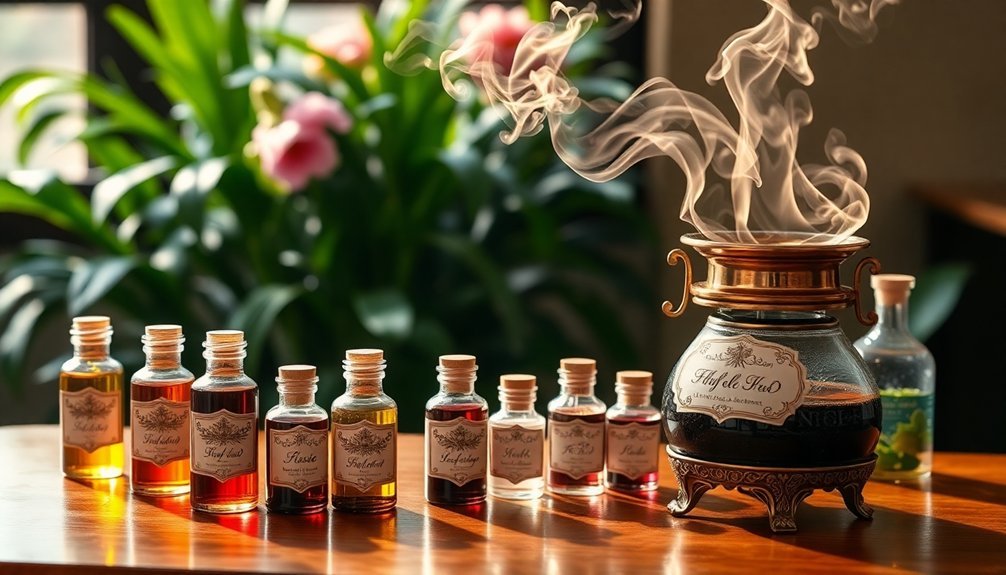
Creating harmonious oriental perfumes requires mastering the delicate interplay between sweet and smoky elements. You'll need to understand how to pair warm, sweet notes like vanilla and tonka bean with complex smoky elements such as birch tar and guaiac wood.
| Sweet Notes | Smoky Notes |
|---|---|
| Vanilla | Birch Tar |
| Tonka Bean | Guaiac Wood |
| Benzoin | Frankincense |
| Gourmand Accords | Lapsang Souchong |
| Fruity Notes | Smoke Profiles |
To achieve balance, start by layering gourmand accords with smoke elements. You'll find that smoke introduces a savory contrast when paired with vanilla or tonka bean. Try combining these with spices like cinnamon or clove for added warmth and complexity. For inspiration, look to fragrances like Maison Margiela's By the Fireplace or Serge Lutens' Chergui, which masterfully blend sweet and smoky elements.
The Magic of Amber and Vanilla Combinations
When you pair amber's resinous warmth with vanilla's creamy sweetness, you'll create a mesmerizing base that anchors any oriental fragrance.
The combination releases a potent sensuality, with amber's pine-leather notes intensifying vanilla's cozy embrace.
You can enhance this duo's impact by carefully layering complementary notes like tonka bean or musk, which amplify the rich, smoky-sweet foundation.
Sensual Base Notes Pairing
Although perfumery offers countless combinations of base notes, the pairing of amber and vanilla stands out as one of the most enchanting duos in oriental fragrances.
You'll find this luxurious combination creates a sensual, comforting experience that's perfect for evening wear or intimate moments.
To maximize the impact of these notes, consider these essential pairing techniques:
- Layer your scents gradually, starting with a vanilla-based lotion before adding amber perfume
- Apply amber to pulse points like wrists and neck, then overlay with vanilla fragrance
- Choose lighter blends for daytime wear and richer combinations for evening events
- Add depth with complementary notes like sandalwood or rose
- Balance the intensity by starting light and building up slowly
You'll discover that mastering these pairings transforms your fragrance game into an art form.
Rich Resinous Heat Layering
Three distinctive qualities make amber and vanilla layering a mesmerizing art in oriental perfumery: their resinous depth, radiant heat, and remarkable longevity.
You'll find this combination's true magic in its rich, warm undertones enhanced by benzoin and labdanum resins.
To master this layering technique, start with a vanilla-forward fragrance like Zara Supreme Vanilla, then add an amber-rich scent such as Lattafa Nebras.
The result delivers an intoxicating blend where spiced notes of cinnamon and clove dance with honeyed sweetness.
You'll notice how the initial burst transforms into complex heart notes before settling into a deep, resinous base that lasts for hours.
This pairing works exceptionally well in cold weather and evening settings, wrapping you in a luxurious, sophisticated aura.
Building Layers With Precious Woods

The art of layering precious woods in oriental perfumes requires a masterful understanding of how different wood notes interact and evolve.
You'll want to start with a strong foundation using sandalwood's creamy richness and cedarwood's sturdy presence. These precious woods create the perfect base for your oriental masterpiece.
Build your composition by incorporating these essential layers:
- Start with eaglewood or oud as your precious wood anchor
- Layer sandalwood and cedarwood for a rich, sturdy foundation
- Add Buddha wood in the heart notes for unique woody depth
- Incorporate patchouli to enhance the woody elements
- Top with pine and spruce notes for dimensional complexity
For lasting power, blend these woods with MCT coconut oil as your carrier.
This will allow the fragrance to mature beautifully while maintaining its precious wood character.
Incorporating Traditional Middle Eastern Resins
Mastering the use of traditional Middle Eastern resins will elevate your oriental perfume to new depths of complexity and authenticity.
You'll want to focus on key resins like styrax, with its rich balsamic notes, and benzoin, known for its heady sweetness. These resins don't just add fragrance – they act as natural fixatives to extend your perfume's longevity.
Start by incorporating resins through traditional methods. You can use destructive distillation for a smoky facet or blend them directly with other oils.
Layer your resins carefully, as they're potent base notes that will anchor your composition. Consider combining styrax with precious woods or adding benzoin to create a sweet, ambery foundation.
Remember that in Middle Eastern perfumery, resins aren't just fragrance elements – they're sacred materials with centuries of cultural significance.
Expert Tips for Fragrance Longevity
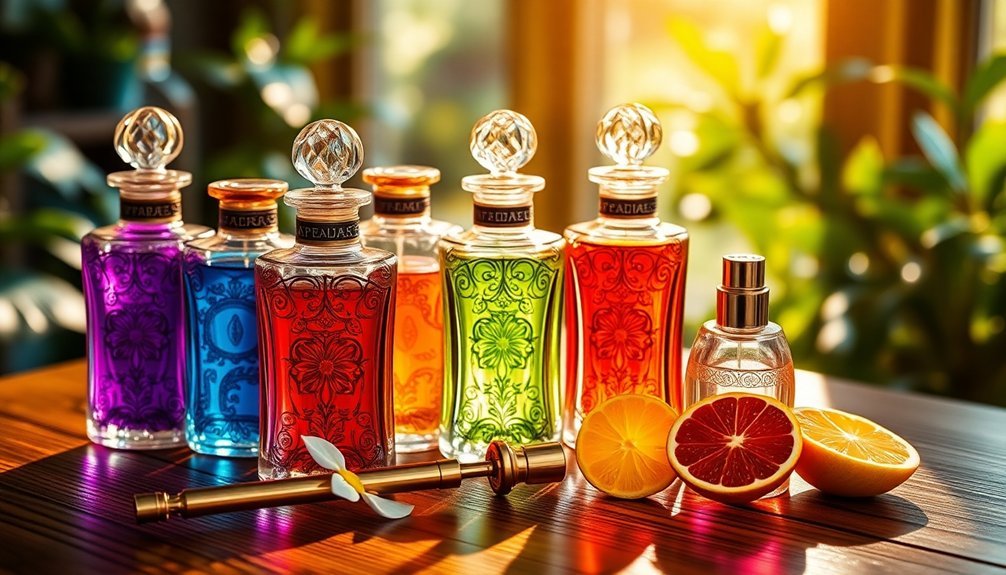
Professional perfumers understand that achieving long-lasting fragrance requires more than just selecting quality ingredients – it demands proper preparation and application techniques.
To maximize your oriental perfume's longevity, you'll need to create the perfect foundation and follow proven application methods.
- Moisturize your skin before applying fragrance, as hydrated skin retains scent considerably longer than dry skin.
- Choose an eau de parfum concentration (15-20% oils) rather than lighter alternatives for extended wear.
- Apply directly to pulse points like wrists and neck, but don't rub – let the fragrance air dry naturally.
- Layer complementary scented products, starting with matching body wash and lotion.
- Store your perfumes in a cool, dark place and consider using Vaseline on pulse points to trap the scent.
These strategies will help your exotic oriental blend maintain its enchanting presence throughout the day.
Seasonal Oriental Blend Formulations
Seasonal changes dramatically influence how oriental perfumes interact with your skin and environment, making it essential to adjust your fragrance formulations throughout the year.
In winter, focus on heavy base notes like woody, vanilla, and musk for lasting warmth. You'll want rich ingredients like cinnamon and grey amber.
As spring arrives, shift to lighter compositions with green almond and jasmine, balanced by floral-praline notes and citrus accents.
For summer, create cooler interpretations using aquatic notes, frozen apple, and Italian bergamot. Add mint and lavender for a revitalizing twist while maintaining the oriental character.
When autumn returns, incorporate warm spices like saffron and nutmeg, layered with chocolate praline and honey. You'll find cedar wood and amber create an especially comforting autumn presence.
Time-Tested Oriental Perfume Recipes
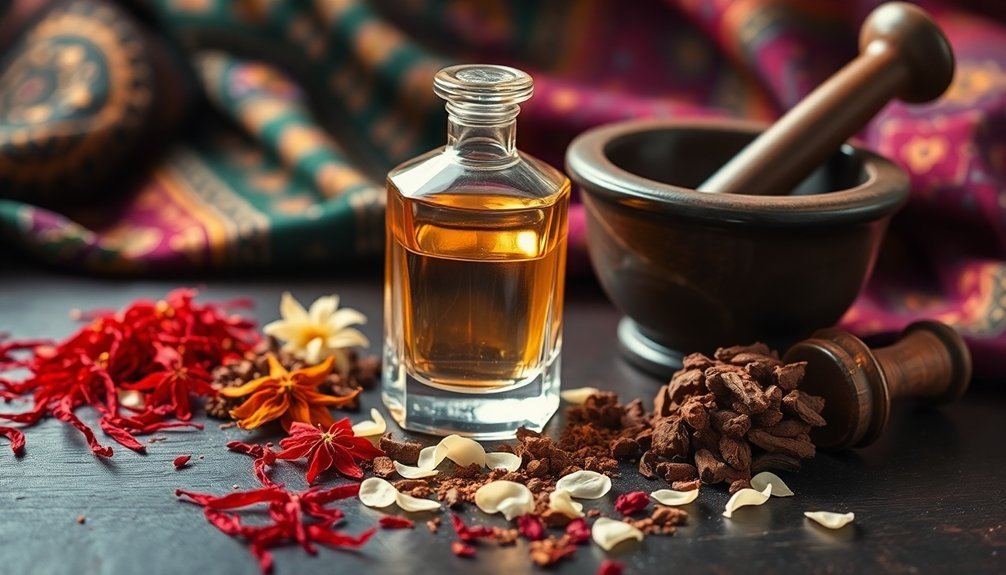
Treasured through generations, oriental perfume recipes have evolved from ancient royal courts to modern-day formulations while maintaining their luxurious essence.
You'll find that historical blends like Henry VIII's perfume offer a foundation for creating your own exotic scents. When crafting these time-tested recipes, remember to follow the essential 20% concentration ratio and allow your blend to mature.
Mix your own classic oriental perfume with these proven combinations:
- Frankincense and myrrh with fractionated coconut oil for a traditional sacred blend
- Patchouli and sandalwood balanced with sweet almond oil for a deep, woody aroma
- Clove and myrrh mixed in grapeseed oil for a warm, spicy signature scent
- Sandalwood and frankincense in sunflower oil for a smooth, royal fragrance
- Patchouli and clove with safflower oil for an earthy, oriental classic
Frequently Asked Questions
Can Pregnant Women Safely Wear Oriental Perfumes?
You should limit your use of oriental perfumes during pregnancy, as they often contain strong synthetic musks and phthalates. If you choose to wear them, use sparingly and consider switching to phthalate-free alternatives.
What's the Best Way to Remove Oriental Perfume Stains From Clothing?
First, blot the perfume stain with a clean cloth, don't rub. Mix equal parts vinegar and water to pre-treat, then wash in cold water. If the stain persists, try baking soda paste.
Do Oriental Perfumes Smell Different on Various Skin Types?
Yes, oriental perfumes will smell uniquely on your skin type. If you've got oily skin, you'll notice richer, longer-lasting scents, while on dry skin, they'll develop faster but fade quicker.
Are Synthetic Alternatives as Effective as Natural Oriental Perfume Ingredients?
While synthetic alternatives can effectively replicate oriental notes, you'll notice they lack the depth and complexity of natural ingredients. However, they're more consistent and stable in your perfume's performance over time.
Can Oriental Perfumes Trigger Allergic Reactions in Sensitive Individuals?
Yes, you'll find oriental perfumes can trigger significant allergic reactions if you're sensitive. They often contain common allergens like Balsam of Peru, cinnamal, and natural oils that may cause skin rashes and respiratory symptoms.
In Summary
You're now equipped with the ancient art of oriental perfumery. By mastering base notes, spice accords, and resin blending, you'll create fragrances that capture the mystique of the East. Remember to balance sweet and smoky elements while considering seasonal variations. Whether you're crafting your signature scent or following traditional recipes, your newfound knowledge will help you blend exotic oriental perfumes with confidence and expertise.
References
- https://graziamagazine.com/us/articles/oriental-scents-women-find-your-perfume/
- https://www.pairfum.com/oriental-perfume-a-journey-through-balsamic-scentscapes/
- https://lib.duan.edu.ua/images/PDF/konfer/filol/kfilol8.pdf
- https://www.nicheperfumes.co.za/fragrance-families-oriental
- https://sedralkhaleej.com/en/blogs/blog/best-oriental-ingredients-for-your-perfumes
- https://50-ml.com/costume-national-soul-parfum-100-ml
- https://archive.org/stream/prefacetocritica00alti_0/prefacetocritica00alti_0_djvu.txt
- https://pafory.com/products/oriental-perfumes
- https://pdfs.semanticscholar.org/6466/415a7a72327307a17233dbdec0c1d5ab2bec.pdf
- https://majouri.com/products/oriental-soul-unisex-oriental-perfume

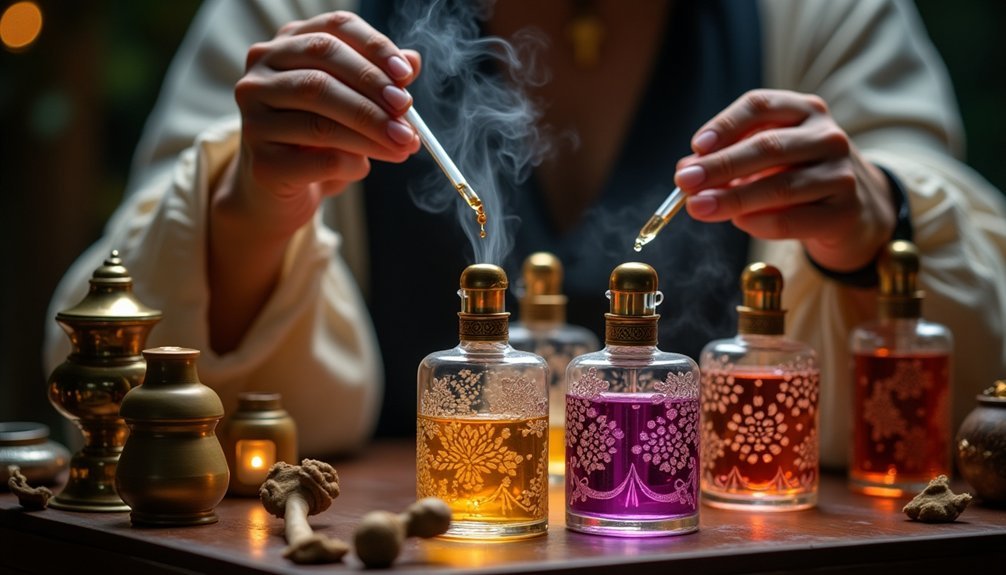

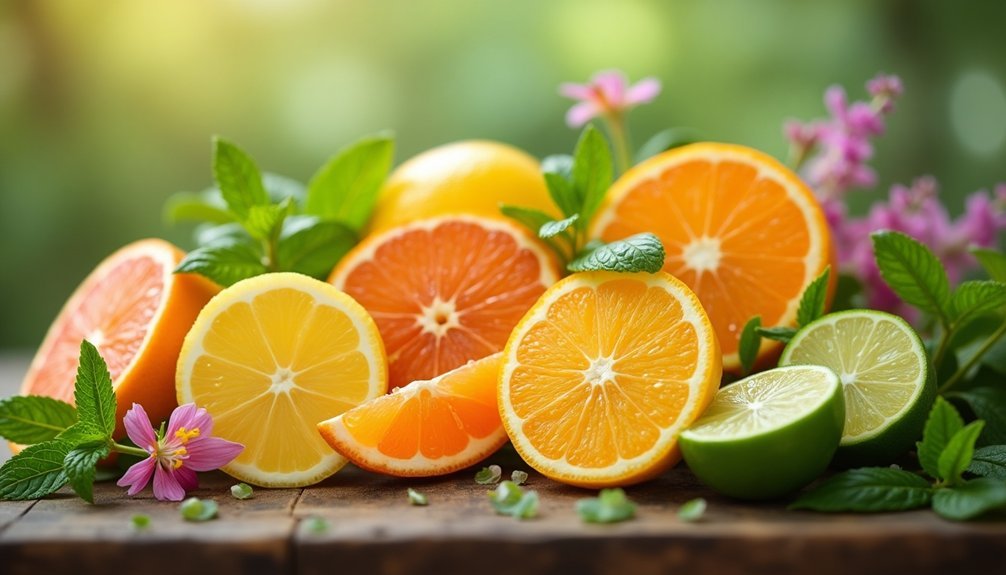
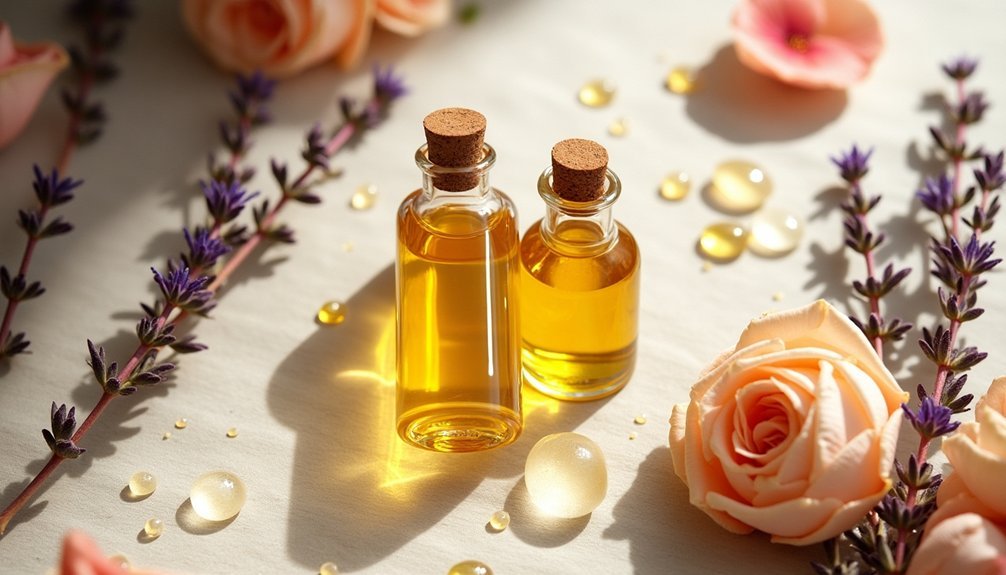
Leave a Reply